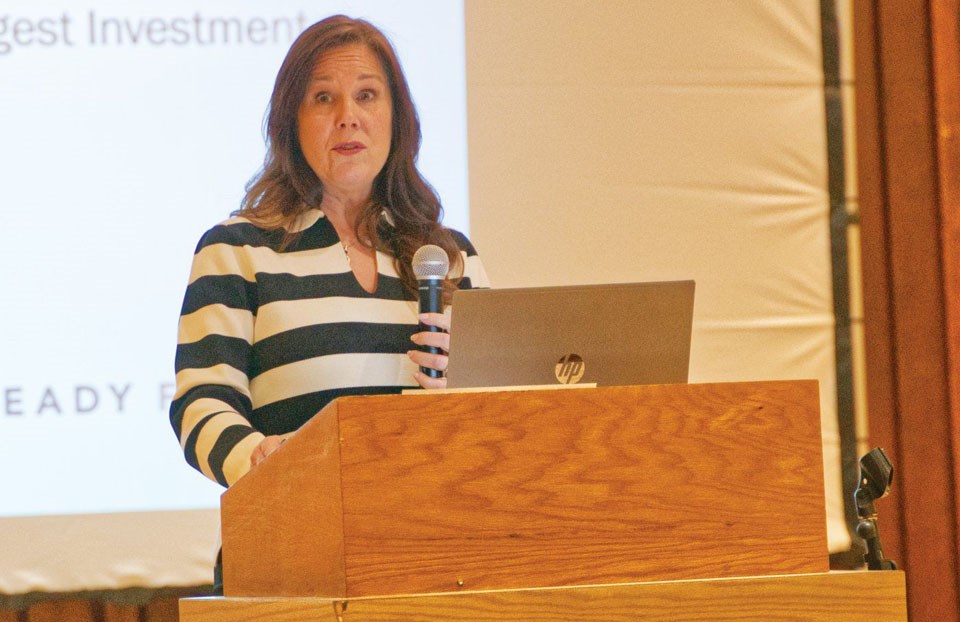ESTERHAZY — Often, when the topic of succession planning arises, the assumption is that the action occurs at the end of a long, multi-generational run. But life doesn’t always work out that way. To better prepare local businesses for that crucial transitioning step regardless of when it happens, the Esterhazy Economic Development Committee hosted a half-day succession readiness workshop with guest speaker Cindy Reid on Feb. 12.
“Prior to working for the town, I was a small business owner for just about 20 years,” explained Tammy MacDonald, CAO with the Town of Esterhazy. “When I needed to exit out and sell that business, I had no clue because we already started moving into another business venture. I had no clue what the value of my business was, I just knew how to work. I knew how to be successful, how to bring clients, and how to answer to my accountant all the time, but I didn’t know what my exit strategy should look like, and I struggled because I was ready for next and I wanted to move on to other things, but I didn’t know where to turn.”
Fast-forward to 2023 when MacDonald and Esterhazy’s Economic Development Officer, Crystal Sabo, were at a conference in Saskatoon when a speaker outlined what business succession plans could offer.
“When we attend these conferences, we always are looking for something we can bring back to our communities,” MacDonald explained.
That session was Ready for Next, facilitated by Cindy Reid, and upon hearing the content, MacDonald and Sabo agreed “This is amazing—we need to bring this back to Esterhazy for our business owners!”
“We have an amazing downtown community and business community here,” MacDonald said. “This year, we have 201 business licenses that have been sent out. That has risen—three years ago it was 187, last year was 192, and this year now we’re 201 already for 2025. That’s not including some extra transient businesses that come and do one-off things as well.”
Planning is crucial
According to national statistics for small and medium businesses, around 16 per cent of owners have a formal succession plan. With 55 per cent of transitions out of a business being involuntary, the need for a plan is alarmingly important.
“That’s one of the statistics that is glaringly scary for not just our industry, but our economy at large because it’s really difficult to transition the business,” Reid said. “I think that’s why a lot of people don’t do it. They just don’t know where to start.”
Succession planning is not an easy venture, leading to frustration and feelings of helplessness.
“Plans are tricky because it’s not like there’s a format out there where it’s a plug-and-play,” Reid explained. “Depending on who’s doing your planning will also determine the robustness of the plan or the flexibility of the plan.”
Reid is an advocate of gathering all the right players around the table, favouring collaboration as opposed to working in a vacuum.
“It really depends on getting the right people around the table, around whoever it is that needs the advice, and making sure that it’s from a collaborative perspective in a healthy way,” she said. “People think of plans sometimes as an artifact, which it isn’t. It’s a living and breathing thing that needs to be tuned up adjusted or amended. Plans are not static ever. So, as much as they might be super complex, it’s kind of like buying a house—you get the entire house built. That doesn’t mean there’s no maintenance.”
Having worked in the financial industry for 30 years as a complex planner, corporate leader, mentor and coach to top advisors and trusted advisor to business owners, including the agribusiness sector, over that time and the countless conversations with business owners, Reid still finds that just getting the ball rolling is a common problem.
“It is a constant that what you don’t know stops you from starting,” she said. “A lot of times it’s on their minds, but there aren’t tangible steps to address it, or put plans in concrete form. There are lots of plans that are in the ether.”
Well-received
Despite an exceedingly cold day, around 40 people took in the workshop, mostly local, but spanning a diverse range.
“We did have lots of businesses who have been around for many years, who were there, and then we did have a couple that are brand new within the year, so it was interesting to see what they took from it,” Sabo said. “To actually start that plan on paper of what Cindy was talking about, maybe they aren’t quite there yet, but it definitely gave them that push, which is what we were hoping for.”
She also noted the opportunity to network was a real bonus as well, having an environment to collaborate with like-minded individuals.
“I think that’s huge as well for the business community to see that support for one another,” Sabo said.
For businesses that missed the workshop, but are still interested in accessing some of the tools, Sabo noted that the online hub will be available for the next year.
“All the tools are there, like the one-on-one assessment, the micro learnings and all of that,” she said. “That’s all there for that one-year subscription, and we are open if somebody still wants in on that hub, we are still open to get people on there. So if they do want that, they are more than welcome to give us a call.”

.png;w=120;h=80;mode=crop)


